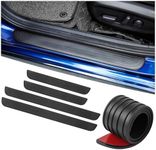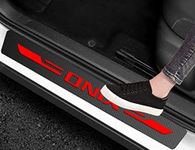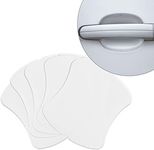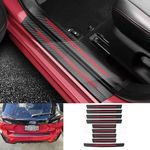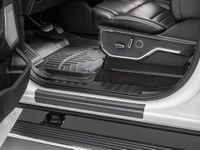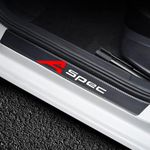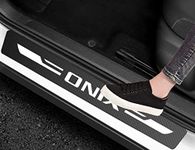Buying Guide for the Best Car Door Sill Protectors
Car door sill protectors are a practical accessory designed to shield the area where you step into your car from scratches, scuffs, and general wear. Choosing the right protector helps maintain your car’s appearance and can even add a touch of style. When shopping for door sill protectors, it’s important to consider a few key features to ensure you get a product that fits well, lasts long, and meets your needs.MaterialThe material of a car door sill protector determines its durability, appearance, and how well it protects your car. Common materials include plastic, rubber, stainless steel, and carbon fiber. Plastic and rubber are flexible and easy to install, making them suitable for everyday protection. Stainless steel and carbon fiber offer a more premium look and higher resistance to scratches, ideal for those who want both style and strong protection. Think about how much wear your car sills get and whether you prefer a subtle or standout look to help you choose the right material.
Fit and CompatibilityFit and compatibility refer to how well the protector matches the size and shape of your car’s door sills. Some protectors are universal, designed to fit most vehicles, while others are custom-made for specific makes and models. Universal options are more flexible but may require trimming, while custom-fit protectors offer a seamless look and easier installation. To pick the right one, check your car’s measurements and decide if you want a tailored appearance or are comfortable with a more general fit.
Installation MethodThe installation method describes how the protector attaches to your car. Most use adhesive backing, which is easy to apply and doesn’t require tools, while others might use clips or screws for a more secure fit. Adhesive options are quick and simple, suitable for most users, but may not be as permanent as mechanical fasteners. If you want a hassle-free setup, go for adhesive; if you need something more robust, consider protectors with additional fastening methods.
Thickness and CoverageThickness and coverage determine how much protection the sill protector offers. Thicker protectors can absorb more impact and resist deeper scratches, while thinner ones are less noticeable but may offer less defense. Coverage refers to how much of the sill area is protected—some cover just the flat part, while others wrap around the edges. If your car sees a lot of foot traffic or you often carry heavy items, opt for thicker, wider protectors. For lighter use or a more discreet look, thinner, narrower options may be enough.
Style and FinishStyle and finish relate to the appearance of the protector, including color, texture, and any decorative elements like logos or patterns. Some protectors are designed to blend in with your car’s interior, while others add a contrasting or eye-catching accent. Consider whether you want the protector to be barely noticeable or to make a statement. Your personal taste and your car’s interior design should guide your choice here.
Ease of CleaningEase of cleaning is about how simple it is to keep the protector looking good. Some materials, like smooth plastic or stainless steel, wipe clean easily, while textured or patterned surfaces may trap dirt. If you want low maintenance, look for protectors with a smooth, non-porous finish. If you don’t mind a bit of extra cleaning, you can choose any style you like.






